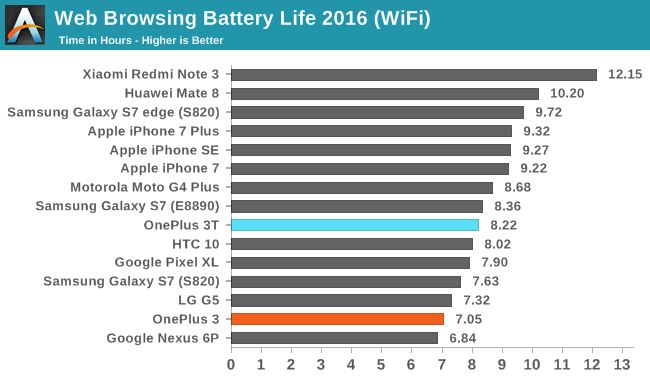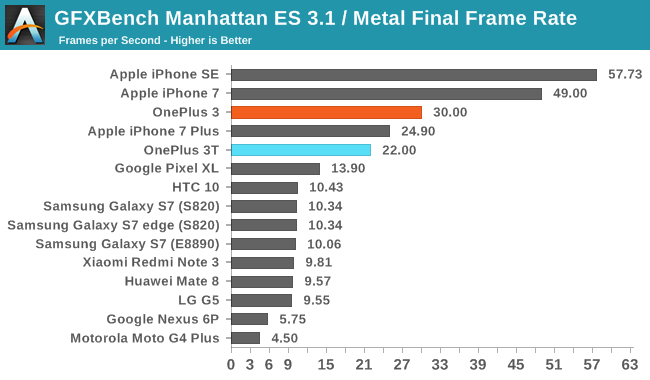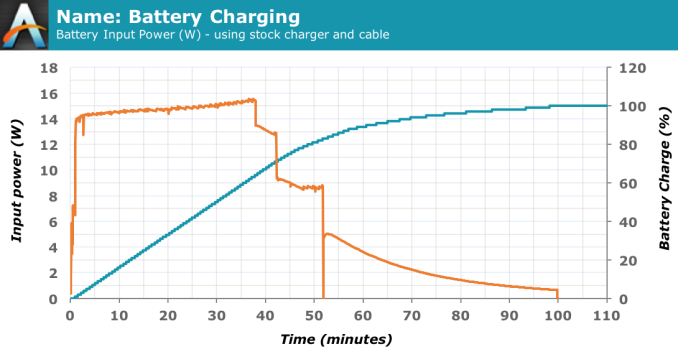The OnePlus 3T Review
by Brandon Chester on November 28, 2016 10:30 AM EST- Posted in
- Smartphones
- OnePlus
- OnePlus 3T
Battery Life
The OnePlus 3T has the same dimensions and mass as the OnePlus 3, but one of the internal changes is an increase in the battery capacity from 3000mAh to 3400mAh courtesy of improvements in battery density. This represents a capacity increase of slightly over 13%, and given that the OnePlus 3T has essentially the same hardware platform as the OnePlus 3 one can expect to see a corresponding increase in battery life due to the capacity increase alone. Any improvements in SoC efficiency and energy optimizations in the software could lead to even further improvements.
To examine the degree of improvement in battery life that the OnePlus 3T brings to the table I've run our standard set of battery benchmarks, which includes our web browsing battery test, and PCMark battery.

In our web browsing battery test the OnePlus 3T lasts 16% longer than the OnePlus 3, which is slightly longer than you'd get by simply scaling to match the 13% increase in battery capacity. Of course, there's always a degree of variance, along with differences in power usage for different SoCs and different bins of the same SoC, and these factors play a role in the outcome of the test. In any case, the increase in battery capacity comes without an increase in mass or size, so it's really just an extra hour or so of web browsing without compromising any other parts of the phone.

PCMark's battery life test runs through the same mix of tasks that emulate what users actually do with a device, so it provides a good idea of how much active usage a user can expect from a device. In this test the OnePlus 3T lasts 10% longer than the OnePlus 3, which is in line with the expected improvement from the increased battery capacity when you factor in slight differences in device platform power and test variance. This increase brings the OnePlus 3T slightly ahead of Samsung's Galaxy S7 Edge, which is a good improvement when one considers that the OnePlus 3 was beaten by the significantly smaller Exynos version of the Galaxy S7.


GFXBench demonstrates that the throttling behavior for the GPU has been changed either with the OnePlus 3T or in a newer version of OxygenOS than was available when I reviewed the OnePlus 3. I plan to re-run this test on the OnePlus 3 when OxygenOS 3.5.1 is made available for it to see if the behavior has changed. Essentially, the phone now exhibits more throttling during the test. The OnePlus 3 dropped down to a nearly constant 30fps in the Manhattan battery test, which meant if it were a real game you'd have a playable frame rate. The OnePlus 3T doesn't do as well. It drops from its peak of 33fps down to 26fps within the first twenty minutes, and slightly past forty minutes into the test it begins to oscillate rapidly between 22fps and 25-26fps.
This behavior leads to a substantial increase in battery life, but comes at the cost of performance. If this were a real game, the performance would not be sufficient on the OnePlus 3T during its 3.5 hours of battery life, while the OnePlus 3 will have lasted only 2.15 hours but maintained a sufficient frame rate for the entirety of the session.
Charge Time
Recently we have run into issues with charge time testing due to new restri ctions introduced in Android Nougat. To get around these I developed an app that we will use internally for measuring charge time. This app uses the same data set as our previous methodology, but accesses it using Android's system APIs rather than by polling the files on the disk directly. This means the results are directly comparable to ones obtained in the past, and the methodology should continue to work for the foreseeable future assuming the device's manufacturer hasn't broken the API, which unfortunately has been the case on some devices that we've tested internally.
The OnePlus 3T still ships with Android Marshmallow, so the old method of battery life testing could still be applied. However, I felt that this would be a good time to get the ball rolling with our new testing app, and I just wanted to make it clear to interested readers that we have a solution in place so we do not again encounter the issues with testing this that we did when reviewing the Pixel XL.

As expected, the OnePlus 3T takes longer to charge than the OnePlus 3, with the increase being strongly correlated to the amount that the capacity of the battery has increased. Dash Charge is still incredibly quick though, so I don't think users will have any complaints about the phone taking too long to charge. The only downside is that Dash Charge being exclusive to OnePlus means that you can only charge quickly using OnePlus's special charger and cable. I think most users end up using the block provided with their phone, but it does mean that you won't get fast charging speeds when borrowing someone else's charger, and if you end up having to buy another you can't buy a charger that supports USB Power Delivery or Qualcomm Quick Charge and utilize fast charging.












104 Comments
View All Comments
AbRASiON - Thursday, December 1, 2016 - link
Still no wireless charging? It's nearly 2017,.........negusp - Thursday, December 1, 2016 - link
Its not really necessary especially with quick charge. I mean, its a relatively useful feature but few people use it and its a hassle to incorporate.Saihtam - Tuesday, December 6, 2016 - link
"No wireless charging in nearly #NextYear" doesn't really make sense.Wireless charging has been out there for years now and it kind of sucks.
I had it on my Nexus 5 but I don't miss it one bit since migrating to the OnePlus 3 with Dash Charging.
leexgx - Wednesday, January 18, 2017 - link
i like wireless charging but never used it myself (i guess main issue is 500ma charge compared to 2-3A on Quick charge 2-3 phone) guess its good for overnight charge or when your at work you put it down on the charge pad saving the USB port from repeated use and accidental damagewith my CUBOT H1 had fast charge as takes like 3 hours to charge from empty but lasts 7 hours "Real" screen on time so less an issue , the S5 charges 90% in about 1hour (i have to charge it again once or twice in the day due to my use, most people seem to have to recharge once in a day to top it up)
kyaaaaaaaaaa - Friday, December 2, 2016 - link
Is there a chance that they will ever use a physical home button again? Also if there is one more camera shutter button and all buttons are all programmable it would be GREAT.sinsin - Monday, December 5, 2016 - link
One area that wasn't touched was wheather the new ISP for 821 improves the camera experience?blomquist - Tuesday, December 6, 2016 - link
Why do you still use this meaningless display tests. I've found every iPhone to have a mediocre screen since I got my private Nexus 5. Since then I had a Honor 6 Plus, a Oneplus X an now I'm using a ZUK Z2 Pro. Provided from my company I had a Iphone 4, 5 and now a 6s - How blind eyed has one to be to not find the iPhones having a mediocre display? I mean they are really shitty, the Honor 6+ still beats them all regarding the display quality.vampyren - Monday, December 12, 2016 - link
This top of the line phone cost $439 and the conclusion focuses on $40 price increase :) its just funny. I understand the comparison against the base prist of OP3 but still.RACE9f - Wednesday, December 14, 2016 - link
a glowing review. Having been trying to buy this since the day this article came out, it seems the phone is vaporware. the support for this firm is really shaky, they only answer a phone call even occasionally and will not take any email unless you already have bought one!danitkd - Tuesday, January 3, 2017 - link
Why in srgb the white is yellow than in ntsc (profile default?)